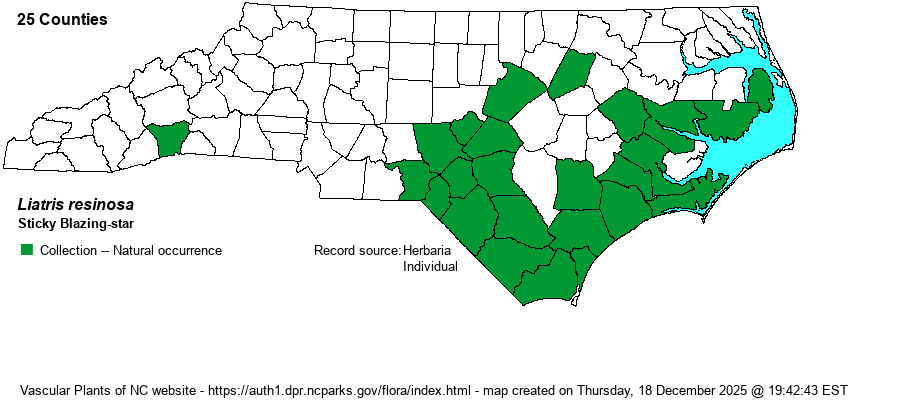| Author | Nuttall | |
| Distribution | Coastal Plain and Sandhills; disjunct to Henderson County (Flat Rock, Memminger s.n. NCU).
Coastal Plain, southern NJ to southern FL and LA. | |
| Abundance | Uncommon to common. Note that Weakley (2022-24) has this taxon pulled out from the mostly montane L. spicata as a valid species. | |
| Habitat | Wet Longleaf Pine-Wiregrass savannas and flatwoods, ecotones of pocosins, blackwater streamheads and ecotones, wet/moist powerline clearings. |
| Phenology | Flowering and fruiting August-September into early October. | |
| Identification | Blazing-stars typically have single stems, many slender leaves, and a terminal spike-like inflorescencxe of disk florets only. They grow from very hard, roundish, underground corms. Resinous Blazing-star grows 2-5 feet tall, one stem from a single corm, stems erect, lower leaves lance-shaped, mid and upper leaves abruptly narrower, shorter, and stalkless. Heads are numerous in a dense spike, have 5-8 red-purple florets, and occur all round the stem. Liatris spicata differs in having leaves gradually smaller up the stem, usually longer involucral bracts, and usually more florets per head. That species is limited mainly to montane areas, often in meadows and other upland sites. A specimen from Carteret County (Atha 9197 NCU), originally determined as L. elegantula, proves to be immature and smaller than usual L. resinosa. | |
| Taxonomic Comments | Note that the distributions of L. resinosa and L. spicata do not overlap in NC. Weakley (2024) elevates each to full species status, saying of spicata: "Blooming earlier than the coastal L. resinosa, even though occurring inland, more northerly, and at higher elevations".
| |
| Other Common Name(s) | Dense Blazing-star | |
| State Rank | [S3S4] | |
| Global Rank | G5T3T5 [G3G5] | |
| State Status | | |
| US Status | | |
| USACE-agcp | | |
| USACE-emp | | |

